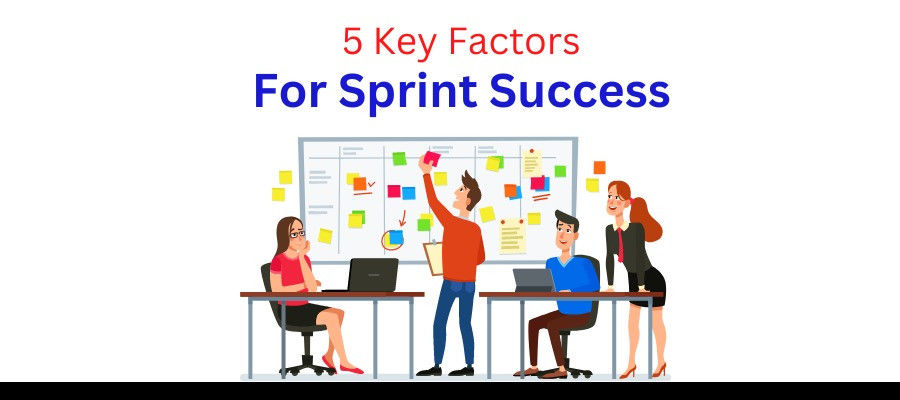5 Key Factors For Sprint Success

Sprint is a time-boxed iteration of the SDLC (Software Development Life Cycle), popularly used in Agile Project Management. It states a planned amount of work for the development team to work on within a planned amount of time. Every Sprint has a pre-defined Sprint Goal for the teams to achieve. When the Sprint ends, the Scrum Master conducts the Sprint Review to understand how much work has been done in that Sprint. The Sprint is considered to be successful if the development team succeeds to meet the Sprint Goal 100% and a few more factors. In this guide, we will discuss the top 5 factors that determine Sprint’s success in Scrum methodology!
1. Fixing The Sprint Length
The Sprint Length is the course of time that the Developers commit for one Sprint. When the Product Owner defines the Product Roadmap, the Scrum Team decides the number of Sprints to complete the Product Goal. Based on the number of total Sprints, it’s the responsibility of the Scrum Master to decide each Sprint’s length. Most Sprints in Agile Environment have lengths of 1 to 4 weeks. However, Sprint Length can change as per the Sprint Goal.
Many development teams pick a Sprint Length depending on the amount of work they are responsible for completing during that Sprint. But only fixed Sprint Length increases the chances of delivering 100% on a continuous basis. Hence the Certified Scrum Master must fix the Sprint Length for all team members to follow.
2. Accomplishing The Sprint Goal
The Sprint Goal defines the Sprint Objectives for the entire team. Consider it as the commitment made by the Developers, Testers, and System Admins to achieve the agreed target by the end of the Sprint. Naturally, it boosts cohesiveness and focus among the development team, encouraging them to work collaboratively with the Scrum Team for the same project goals.
Once the Scrum Master fixes the Sprint Length, it’s time to set the Sprint Goal. The Product Owner participates in Sprint Goal setting and conveys the stakeholder requirements to the development team. It helps the team to define the Defining of Done for that particular Sprint. Hence, the accomplishment of the Sprint Goal acts as a key factor to determine Sprint’s success.
3. Conducting Successful Sprint Planning
It’s often seen that the Agile Teams rush to start working at the very beginning of the Sprint without proper planning. As the teams remain unclear about the Sprint Goal, it becomes difficult for the team to work and develop different User Stories.
Hence, the Scrum Master must conduct a collaborative Sprint Planning session with the entire team. Every team must participate in Sprint Planning with a clear mindset to understand the Sprint Goal. The team members must participate in doing high-level story point estimations based on the Sprint Goal.
During Sprint Planning, the development team can break down the work items to clarify each functional area or individual task. The teams can perform capacity planning and allocate enough time to complete individual work items within the Sprint.
4. Eliminating Unclear Items With Backlog Refinement
Product Backlog Refinement is very important for the upcoming Sprint’s success. Even though it is an ongoing process, the Product Owner must collaborate with the Development Team to ensure that all Product Backlog Items are well understood by everybody. Here are a few tips to perform continuous Backlog Refinement:
- Consistent product discovery to improve the product features and functionalities.
- Removing unclear work items that are irrelevant for that particular Sprint.
- Adding more details in User Stories to prevent any misunderstanding.
- Splitting large work items into smaller tasks to get them completed faster.
- Resizing and re-prioritizing work Items based on the Sprint Goal.
- Identifying potential risks and challenges among Product Backlog Items.
With proper Backlog Refinement, the Developers can aim toward a successful Sprint completion.
5. Reviewing Sprint Deliverables
Based on the Sprint Length, it’s important to conduct Sprint Review sessions from time to time. The Scrum Master can utilize a few minutes from the Daily Scrum Meeting to review Sprint’ work progress. It’s an effective way to determine how much time the Developers need to wrap up their development activities as per Sprint’s deadline. Here are a few tips for the CSM to follow:
- Review all sprint deliverables to eliminate any potential blockers.
- Review the team's velocity to perform velocity-driven Sprint Planning.
- Review all new User Stories before adding more tasks to the teams.
- Review all open bugs to resolve all code defects before the sprint ends.
- Demonstrate the stakeholders or subject matter experts Sprint’s productive outcome.
Once the Scrum Master reviews the Sprint Deliverables, he gets a hold of the time that is needed to wrap up the Sprint.
Conclusion
A Sprint success is the joint responsibility of the Scrum team, Scrum Master, Product Owner, Project Manager, Developers, Testers, System Administrators, and all other teams. With proper Sprint Planning and a clear Sprint Goal, the Developers can make the Sprint a success!
Reference
- https://www.scrum.org/forum/scrum-forum/32167/sprint-goal-and-sprint-success


